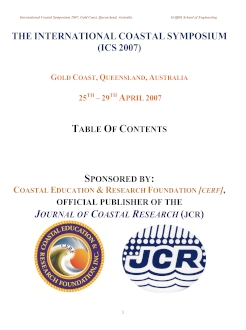Morris, B.D., Coco, G., Bryan, K.R. and Turner, I.L., 2007. Video-derived mapping of estuarine evolution. Journal of Coastal Research, SI 50 (Proceedings of the 9th International Coastal Symposium), 410 – 414. Gold Coast, Australia, ISSN 0749.0208
Coastal changes are being monitored around Australia and New Zealand using a network of state-of-the-art coastal imaging stations. These systems are being used to build a database of frequent, long-term, spatially-extensive observations of coastal behaviour across a diverse range of coastal environments. The focus of the research detailed herein is the application of this technology to the investigation of estuarine systems. Boat-based surveying of estuaries is generally both difficult (e.g. shallow mudflats) and time-consuming. The ability to complete regular and repeated surveys within highly dynamic and fast-changing systems is usually limited. In contrast, image-derived methods provide a practical solution. Digital images are analysed to detect successive (hourly) waterlines at measured water levels through a single tidal cycle and then processed to generate intertidal bathymetries. Repeating these ‘virtual’ surveys enables the quantification of key processes such as channel infilling, growth of intertidal mudflats and response of the estuary to extreme forcing events. A particular advantage of this approach is that archived images may be used to complete ‘surveys’ retrospectively. Application of these research techniques are illustrated at two contrasting field sites in Australia and New Zealand. The first is a dynamic and small-scale inlet system dominated by the ingress of beach sediment (Narrabeen Lagoon, Australia) and the second is a large-scale and more slowly evolving mudflat system (Raglan Estuary, New Zealand). Results presented illustrate the practical application of video-derived methods to the monitoring and quantification of estuarine processes and evolution, and provide a unique dataset that can now be used for comparison with model simulations.





